A New Form of Organization in the factories
Thumbnail
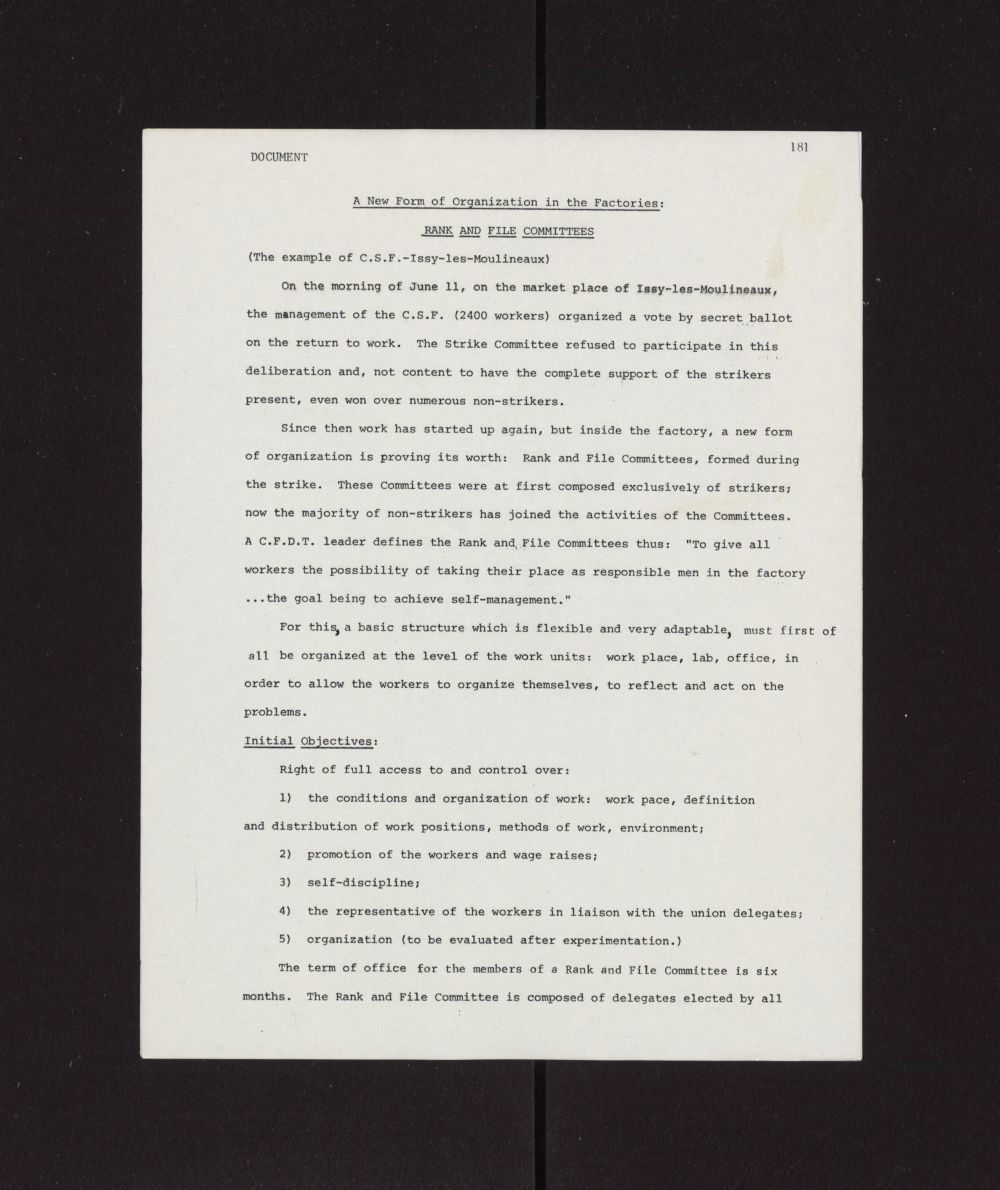

181
DOCUMENT
A New Forin of Organization in the Factories;
.RANK AND FILE COMMITTEES
.RANK AND FILE COMMITTEES
(The example of C.S.F.-Issy-les-Moulineaux)
On the morning of June 11, on the market place of I»«y-les~M0ulinestiic,
the management of the C.5.F. (2400 workers) organized a vote by secret ballot
on the return to work. The Strike Committee refused to participate in this
deliberation and, not content to have the complete support of the strikers
present, even won over numerous non-strikers.
the management of the C.5.F. (2400 workers) organized a vote by secret ballot
on the return to work. The Strike Committee refused to participate in this
deliberation and, not content to have the complete support of the strikers
present, even won over numerous non-strikers.
Since then work has started up again, but inside the factory, a new form
of organization is proving its worth: Rank and File Committees, formed during
the strike. These Committees were at first composed exclusively of strikers,-
now the majority of non-strikers has joined the activities of the Committees.
A C.F.D.T. leader defines the Rank and,,File Committees thus: "To give all
workers the possibility of taking their place as responsible men in the factory
...the goal being to achieve self-management."
of organization is proving its worth: Rank and File Committees, formed during
the strike. These Committees were at first composed exclusively of strikers,-
now the majority of non-strikers has joined the activities of the Committees.
A C.F.D.T. leader defines the Rank and,,File Committees thus: "To give all
workers the possibility of taking their place as responsible men in the factory
...the goal being to achieve self-management."
For this, a basic structure which is flexible and very adaptable, must first of
all be organized at the level of the work units: work place, lab, office, in
order to allow the workers to organize themselves, to reflect and act on the
problems.
Initial Obj_ective_s_:
all be organized at the level of the work units: work place, lab, office, in
order to allow the workers to organize themselves, to reflect and act on the
problems.
Initial Obj_ective_s_:
Right of full access to and control over:
1) the conditions and organization of work: work pace, definition
and distribution of work positions, methods of work, environment;
and distribution of work positions, methods of work, environment;
2) promotion of the workers and wage raises;
3) self-discipline,-
4) the representative of the workers in liaison with the union delegates;
5) organization (to be evaluated after experimentation.)
The term of office for the members of a Rank and File Committee is six
months. The Rank and File Committee is composed of delegates elected by all
months. The Rank and File Committee is composed of delegates elected by all

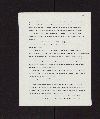
I8!2 '
personnel of the Basic Unit, the number of these delegates is about 10% of
the total membership. Half of them is replaced every three months; no delegate
is eligible two times in a row. The goalrto be attained! thanks to these
methods, is to allow a rotation of all the workers to responsible position.
the total membership. Half of them is replaced every three months; no delegate
is eligible two times in a row. The goalrto be attained! thanks to these
methods, is to allow a rotation of all the workers to responsible position.
The role of the present management with respect to the Rank and File
Committees remains to be defined; one proposition has been discussed, but not
adopted:
Committees remains to be defined; one proposition has been discussed, but not
adopted:
-the foreman {of a work unit) would be a de j^jr_e_ member;
-the representatives of other members of management would be elected
by all the workers.
by all the workers.
At a higher level, i.e. the branch or department, a Branch Committee
would be formed: the emanation of the Rank and File Committee with a representative
of each of those Rank and File Committees and the personnel delegates elected
by each branch. The decisions are coordinated and controlled at the level of
the branch. Finally, at the level of the company as a whole, the Company
Committee, the powers of which would have to be re-evaluated in terms of this
new rank and file organization itself.
would be formed: the emanation of the Rank and File Committee with a representative
of each of those Rank and File Committees and the personnel delegates elected
by each branch. The decisions are coordinated and controlled at the level of
the branch. Finally, at the level of the company as a whole, the Company
Committee, the powers of which would have to be re-evaluated in terms of this
new rank and file organization itself.
After the C.F.D.'T. representative, let us now listen to a C.G.T. militant,
who defines the goals of a Rank and File Committee as follows: "For the unified
workers to concretize—complementary to the unions—the defense of our
interests against all the arbitrary and unjust decisions of the bosses and
management.
who defines the goals of a Rank and File Committee as follows: "For the unified
workers to concretize—complementary to the unions—the defense of our
interests against all the arbitrary and unjust decisions of the bosses and
management.
"The elected representatives can be recalled at any moment if they do
not fulfill the responsibilities given them. They must be renewed every three
months and can be continued in their functions however, it would be preferable
for everyone in turn to become a representative of the workers."
not fulfill the responsibilities given them. They must be renewed every three
months and can be continued in their functions however, it would be preferable
for everyone in turn to become a representative of the workers."
'All these definitions of the role and the goals of the Rank and File
Committees at the C.S.F. have been discussed by the strikers during the
Committees at the C.S.F. have been discussed by the strikers during the
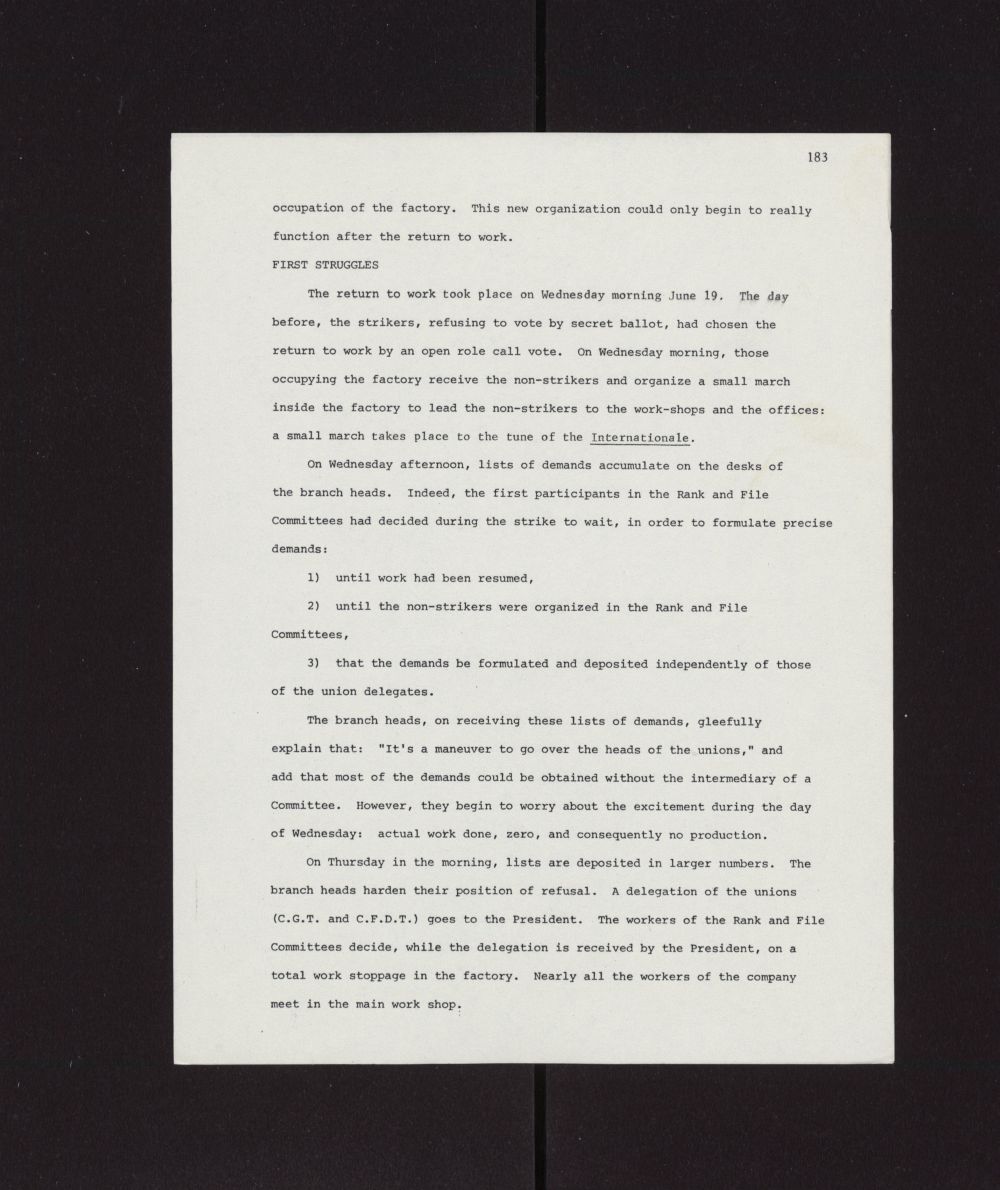

183
occupation of the factory. This new organization could only begin to really
function after the return to work.
FIRST STRUGGLES
function after the return to work.
FIRST STRUGGLES
The return to work took place on Wednesday morning June 19. The
before, the strikers, refusing to vote by secret ballot, had chosen the
return to work by an open role call vote. On Wednesday morning, those
occupying the factory receive the non-strikers and organize a small inarch
inside the factory to lead the non-strikers to the work-shops and the offices:
a small march takes place to the tune of the Internationale.
before, the strikers, refusing to vote by secret ballot, had chosen the
return to work by an open role call vote. On Wednesday morning, those
occupying the factory receive the non-strikers and organize a small inarch
inside the factory to lead the non-strikers to the work-shops and the offices:
a small march takes place to the tune of the Internationale.
On Wednesday afternoon, lists of demands accumulate on the desks of
the branch heads. Indeed, the first participants in the Rank and File
Committees had decided during the strike to wait, in order to formulate precise
demands:
the branch heads. Indeed, the first participants in the Rank and File
Committees had decided during the strike to wait, in order to formulate precise
demands:
15 until work had been resumed,
2) until the non-strikers were organized in the Rank and File
Committees,
Committees,
3) that the demands be formulated and deposited independently of those
of the union delegates.
of the union delegates.
The branch heads, on receiving these lists of demands, gleefully
explain that: "It's a maneuver to go over the heads of the unions," and
add that most of the demands could be obtained without the intermediary of a
Committee. However, they begin to worry about the excitement during the day
of Wednesday: actual work done, zerof and consequently no production.
explain that: "It's a maneuver to go over the heads of the unions," and
add that most of the demands could be obtained without the intermediary of a
Committee. However, they begin to worry about the excitement during the day
of Wednesday: actual work done, zerof and consequently no production.
On Thursday in the morning, lists are deposited in larger numbers. The
branch heads harden their position of refusal. A delegation of the unions
(C.G.T. and C.F.D.T.) goes to the President. The workers of the Rank and File
Committees decide, while the delegation is received by the President, on a
total work stoppage in the factory. Nearly all the workers of the company
meet in the main work shop.
branch heads harden their position of refusal. A delegation of the unions
(C.G.T. and C.F.D.T.) goes to the President. The workers of the Rank and File
Committees decide, while the delegation is received by the President, on a
total work stoppage in the factory. Nearly all the workers of the company
meet in the main work shop.
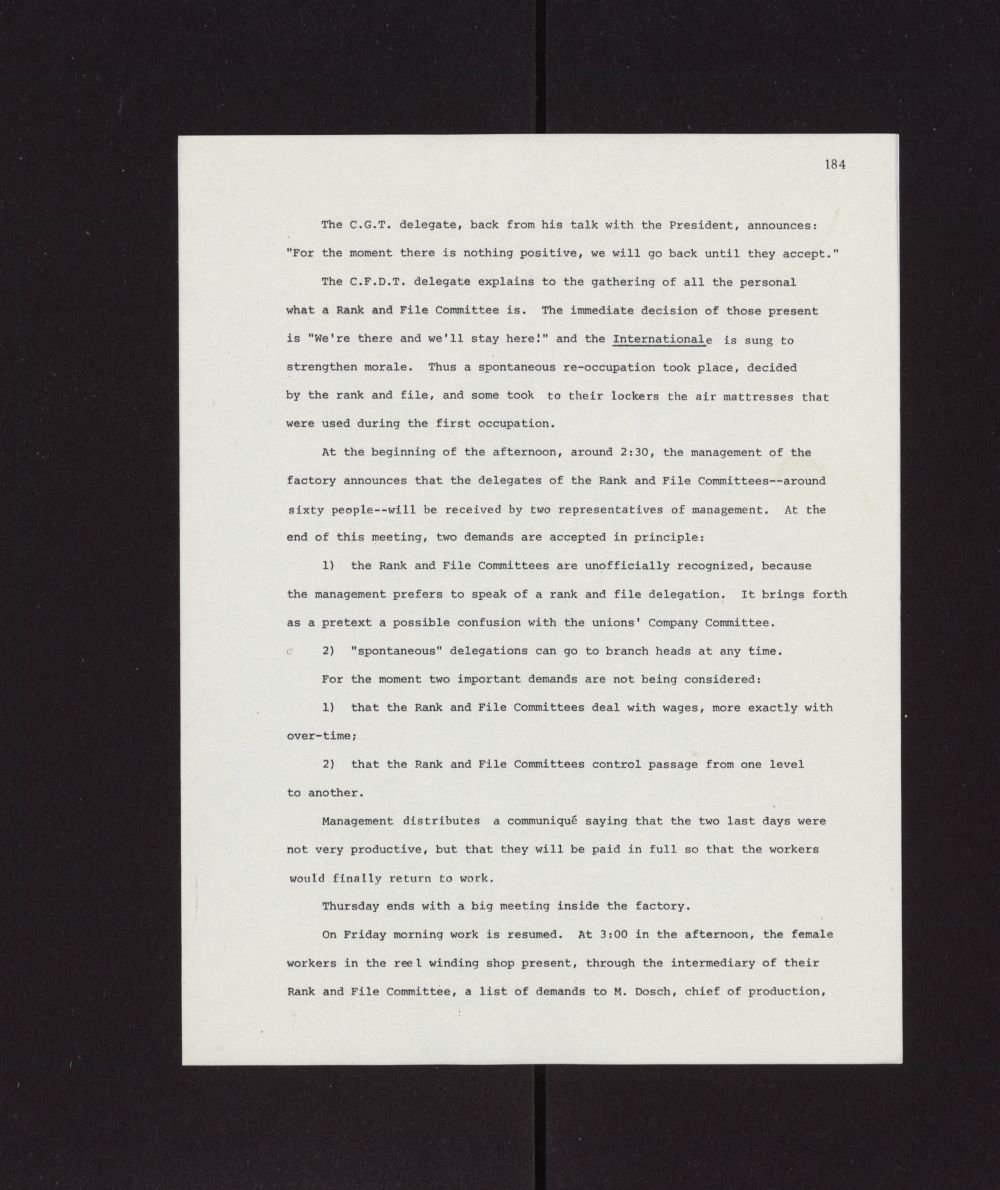

184
The C.G.T, delegate, back from his talk with the President, announces:
"For the moment there is nothing positive, we will go back until they accept."
"For the moment there is nothing positive, we will go back until they accept."
The C.F.D.T. delegate explains to the gathering of all the personal
what a Rank and File Committee is. The immediate decision of those present
is "We're there and we'll stay here!" and the Internationale is sung to
strengthen morale. Thus a spontaneous re-occupation took place, decided
by the rank and file, and some took to their lockers the air mattresses that
were used during the first occupation.
what a Rank and File Committee is. The immediate decision of those present
is "We're there and we'll stay here!" and the Internationale is sung to
strengthen morale. Thus a spontaneous re-occupation took place, decided
by the rank and file, and some took to their lockers the air mattresses that
were used during the first occupation.
At the beginning of the afternoon, around 2:30, the management of the
factory announces that the delegates of the Rank and File Committees—around
sixty people—will be received by two representatives of management. At the
end of this meeting, two demands are accepted in principle:
factory announces that the delegates of the Rank and File Committees—around
sixty people—will be received by two representatives of management. At the
end of this meeting, two demands are accepted in principle:
1) the Rank and File Committees are unofficially recognized, because
the management prefers to speak of a rank and file delegation. It brings forth
as a pretext a possible confusion with the unions' Company Committee.
as a pretext a possible confusion with the unions' Company Committee.
2) "spontaneous" delegations can go to branch heads at any time.
For the moment two important demands are not being considered:
For the moment two important demands are not being considered:
1) that the Rank and File Committees deal with wages, more exactly with
over-time;
over-time;
2) that the Rank and File Committees control passage from one level
to another.
to another.
Management distributes a communique saying that the two last days were
not very productive, but that they will be paid in full so that the workers
would finally return to work.
not very productive, but that they will be paid in full so that the workers
would finally return to work.
Thursday ends with a big meeting inside the factory.
On Friday morning work is resumed. At 3:00 in the afternoon, the female
workers in the reel winding shop present, through the intermediary of their
Rank and File Committee, a list of demands to M. Dosch, chief of production,
workers in the reel winding shop present, through the intermediary of their
Rank and File Committee, a list of demands to M. Dosch, chief of production,

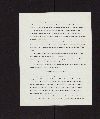
185
who refuses everything wholesale. Dosch and certain
heads, the day after the resumption of work, had started a little tightening
up of discipline by giving foremen the instruction to "turn the screws."
In the following minutes, the reel winding, machine finishing and
building workships stop work. It must be mentioned that these workshops
have the most difficult tasks in the factory. Confronted with this "incredible"
situation, Dosch decides to receive the union delegates and then those of
the Rank and File Committees. After one and a half hour of work stoppage,
Dosch accepts certain essential points from the list of demands. The delegates
even force him to rescind certain arbitrary decisions previously made in his
branch.
building workships stop work. It must be mentioned that these workshops
have the most difficult tasks in the factory. Confronted with this "incredible"
situation, Dosch decides to receive the union delegates and then those of
the Rank and File Committees. After one and a half hour of work stoppage,
Dosch accepts certain essential points from the list of demands. The delegates
even force him to rescind certain arbitrary decisions previously made in his
branch.
Top management had unofficially authorized the lower echelons to grant
the maximum in order to interrupt this new type of movement that was
paralysing the factory. Most of the work stoppages take only a few minutes
to occur and they assemble 700 or 800 workers.
the maximum in order to interrupt this new type of movement that was
paralysing the factory. Most of the work stoppages take only a few minutes
to occur and they assemble 700 or 800 workers.
"Our Struggle," an internal newsletter born during this strike, circulates
among the workers. Here is an extract:
among the workers. Here is an extract:
FIGHTING SPIRIT IS NOT DEAD
On Wednesday the 19th, the day of the return to work, the management
thought it could return to its bad old habits. A few examples: at the
cable shop, attempts at discrimination between strikers and non-strikers;
at the launching shop, arrogance and insults for the women who had been on
strike and had been on night watch? at Debuf's, the women monitors start
noting down the work pace of the ex-strikers and insult them; at the
mecanography shop, insults? at the R.S.M. there is the same atmosphere,
matched by the refusal to recognize the rank and file committees when the
latter wanted to discuss the workshop demands. But they did not reckon with
thought it could return to its bad old habits. A few examples: at the
cable shop, attempts at discrimination between strikers and non-strikers;
at the launching shop, arrogance and insults for the women who had been on
strike and had been on night watch? at Debuf's, the women monitors start
noting down the work pace of the ex-strikers and insult them; at the
mecanography shop, insults? at the R.S.M. there is the same atmosphere,
matched by the refusal to recognize the rank and file committees when the
latter wanted to discuss the workshop demands. But they did not reckon with

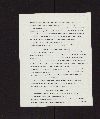
186
our morale and our solidarity and after some often stormy confrontations
management was obliged to knuckle under and wait for "better days".
management was obliged to knuckle under and wait for "better days".
One thing is certain, management will only be able to calm the fears we
have made it feel by reimposing its discipline: M. Dosch said this clearly,
and M. Boudigues, at the meeting of the executives and management, apparently
congratulated them for the discipline that reigned in the factory before
the strike. It must be admitted that they needed encouragement.
have made it feel by reimposing its discipline: M. Dosch said this clearly,
and M. Boudigues, at the meeting of the executives and management, apparently
congratulated them for the discipline that reigned in the factory before
the strike. It must be admitted that they needed encouragement.
On Thursday and Friday our solidarity was manifested: the return
to work does not mean in any way that fighting spirit is blunted.
to work does not mean in any way that fighting spirit is blunted.
LONG LIVE THE RANK AND FILE COMMITTEES
During the struggle we created rank and file committees to represent us.
In certain sectors, the members of these committees are real workshop delegates,
spokesmen for their work comrades and controlled by them. In other sectors,
their contestation even goes so far as to suggest more appropriate methods for
the improvement of work. On the one side there is the role of class struggle,
on the other side that of class collaboration. It would be Utopian to look
for the middle term wanted by some and it is towards the class struggle that
these committees must be oriented. The bosses are quite aware of this and it
is at R.S.M. that they find it hardest to accept them because there the
committees reveal their full efficacy.
In certain sectors, the members of these committees are real workshop delegates,
spokesmen for their work comrades and controlled by them. In other sectors,
their contestation even goes so far as to suggest more appropriate methods for
the improvement of work. On the one side there is the role of class struggle,
on the other side that of class collaboration. It would be Utopian to look
for the middle term wanted by some and it is towards the class struggle that
these committees must be oriented. The bosses are quite aware of this and it
is at R.S.M. that they find it hardest to accept them because there the
committees reveal their full efficacy.
The rank and file committees, elected in each workshop, recallable at
any moment, insure real workers' control over their spokemen and a genuine
representativity. That is why they must be imposed and maintained,
any moment, insure real workers' control over their spokemen and a genuine
representativity. That is why they must be imposed and maintained,
DEMOCRATIC CONTROL OVER ACTION
On Thursday, June 27, after 6 P.M., in a cafetaria, a meeting of about
200 members of the Rank and File Committees is held in a cafeteria. Two
problems are posed at the beginning: the preparation of the return to work
after the holidays and the relations between the strikers and the non-strikers
200 members of the Rank and File Committees is held in a cafeteria. Two
problems are posed at the beginning: the preparation of the return to work
after the holidays and the relations between the strikers and the non-strikers
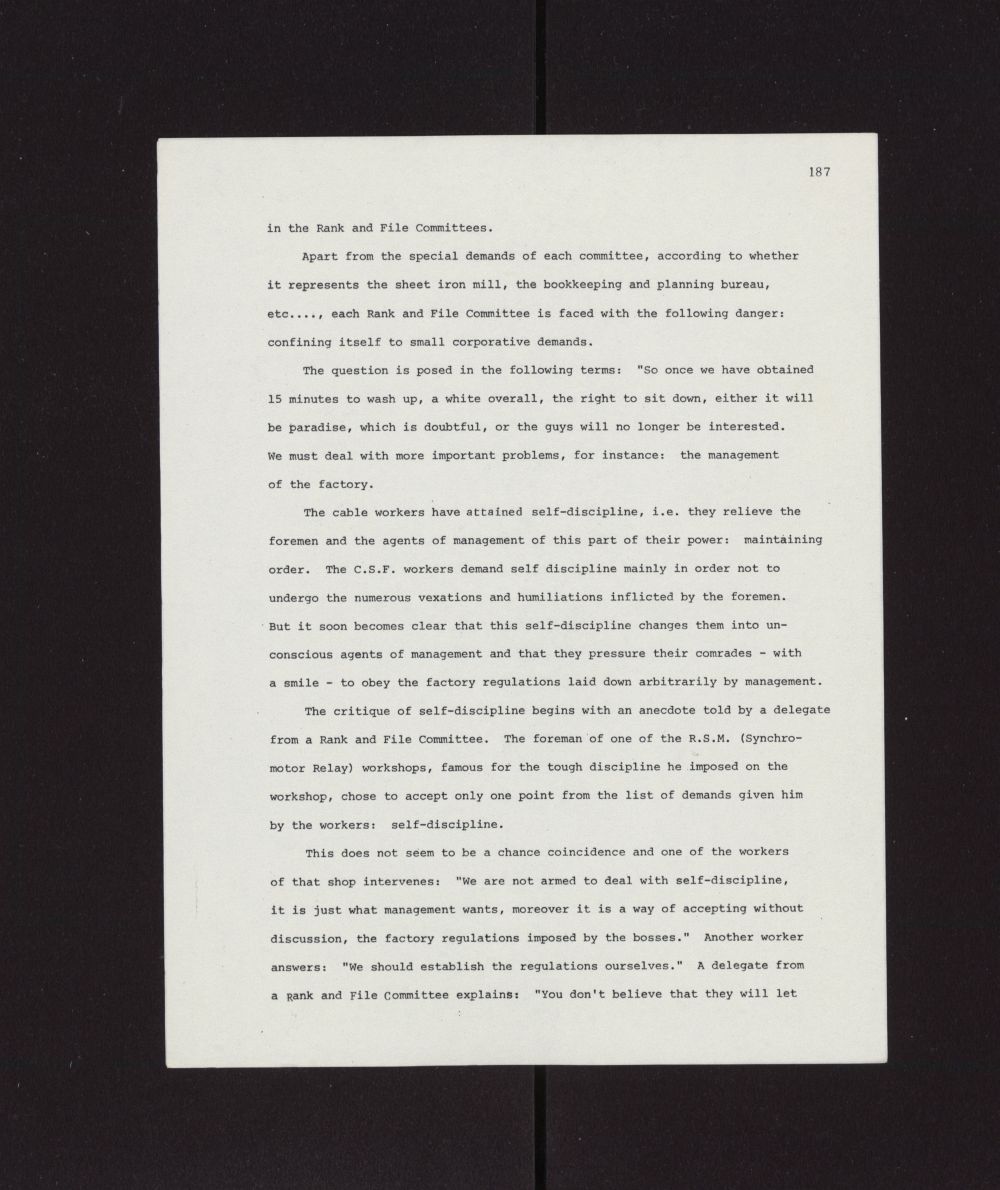

187
in the Rank and File Committees.
Apart from the special demands of each committee, according to whether
it represents the sheet iron mill, the bookkeeping and planning bureau,
etc...., each Rank and File Committee is faced with the following danger:
confining itself to small corporative demands,
it represents the sheet iron mill, the bookkeeping and planning bureau,
etc...., each Rank and File Committee is faced with the following danger:
confining itself to small corporative demands,
The question is posed in the following terms: "So once we have obtained
15 minutes to wash up, a white overall, the right to sit down, either it will
be paradise, which is doubtful, or the guys will no longer be interested.
We must deal with more important problems, for instance: the management
of the factory.
15 minutes to wash up, a white overall, the right to sit down, either it will
be paradise, which is doubtful, or the guys will no longer be interested.
We must deal with more important problems, for instance: the management
of the factory.
The cable workers have attained self-discipline, i.e. they relieve the
foremen and the agents of management of this part of their power: maintaining
order. The C.S.F. workers demand self discipline mainly in order not to
undergo the numerous vexations and humiliations inflicted by the foremen.
But it soon becomes clear that this self-discipline changes them into un-
conscious agents of management and that they pressure their comrades - with
a smile - to obey the factory regulations laid down arbitrarily by management.
foremen and the agents of management of this part of their power: maintaining
order. The C.S.F. workers demand self discipline mainly in order not to
undergo the numerous vexations and humiliations inflicted by the foremen.
But it soon becomes clear that this self-discipline changes them into un-
conscious agents of management and that they pressure their comrades - with
a smile - to obey the factory regulations laid down arbitrarily by management.
The critique of self-discipline begins with an anecdote told by a delegate
from a Rank and File Committee. The foreman'of one of the R.S.M. (Synchro-
motor Relay) workshops, famous for the tough discipline he imposed on the
workshop, chose to accept only one point from the list of demands given him
by the workers: self-discipline.
from a Rank and File Committee. The foreman'of one of the R.S.M. (Synchro-
motor Relay) workshops, famous for the tough discipline he imposed on the
workshop, chose to accept only one point from the list of demands given him
by the workers: self-discipline.
This does not seem to be a chance coincidence and one of the workers
of that shop intervenes: "We are not armed to deal with self-discipline,
it is just what management wants, moreover it is a way of accepting without
discussion, the factory regulations imposed by the bosses." Another worker
answers: "We should establish the regulations ourselves." A delegate from
a Rank and File Committee explains: "You don't believe that they will let
of that shop intervenes: "We are not armed to deal with self-discipline,
it is just what management wants, moreover it is a way of accepting without
discussion, the factory regulations imposed by the bosses." Another worker
answers: "We should establish the regulations ourselves." A delegate from
a Rank and File Committee explains: "You don't believe that they will let
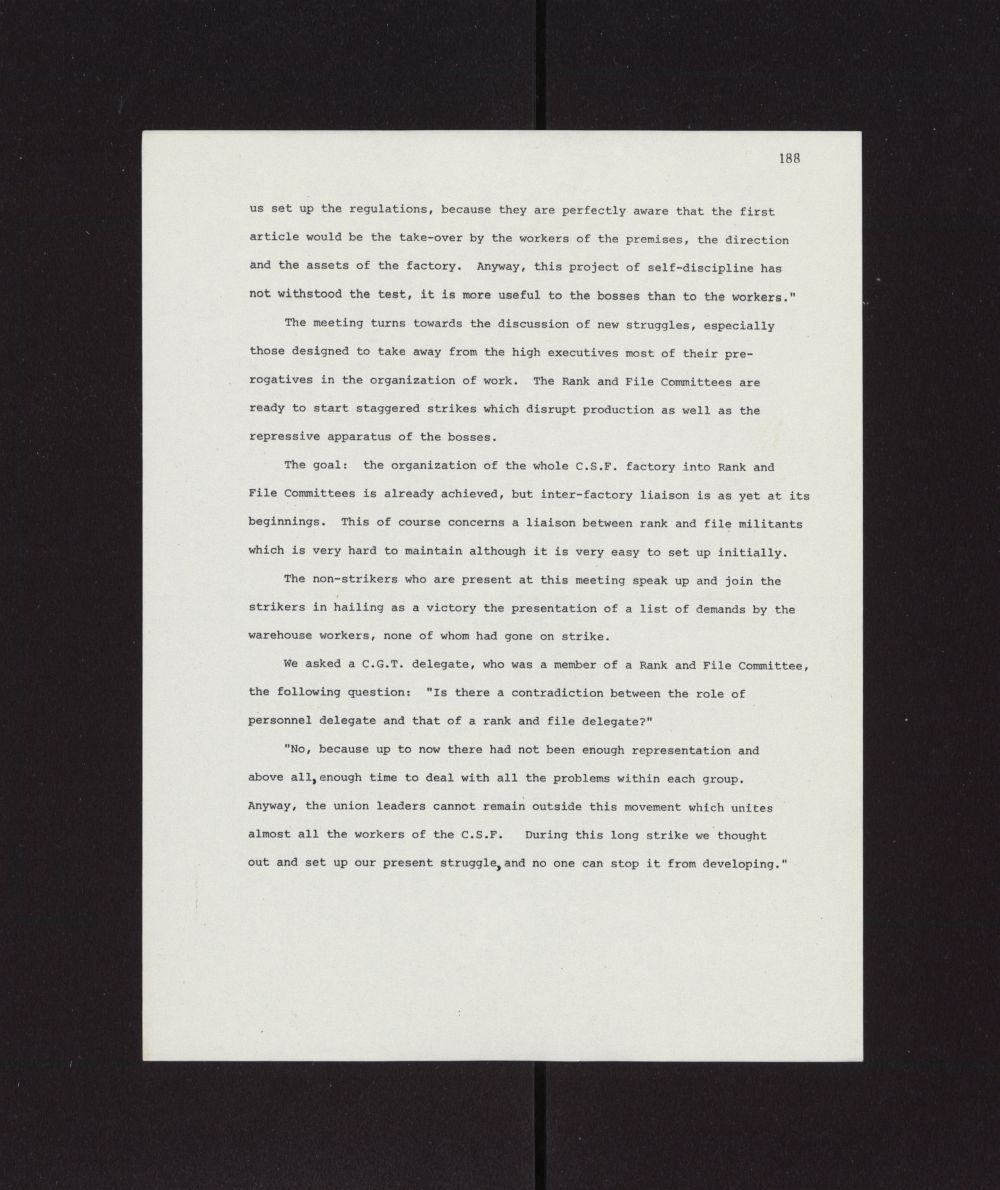

188
us set up the regulations, because they are perfectly aware that the first
article would be the take-over by the workers of the premises, the direction
and the assets of the factory. Anyway, this project of self-discipline has
not withstood the test, it is more useful to the bosses than to the workers."
article would be the take-over by the workers of the premises, the direction
and the assets of the factory. Anyway, this project of self-discipline has
not withstood the test, it is more useful to the bosses than to the workers."
The meeting turns towards the discussion of new struggles, especially
those designed to take away from the high executives most of their pre-
rogatives in the organization of work. The Rank and Pile Committees are
ready to start staggered strikes which disrupt production as well as the
repressive apparatus of the bosses.
those designed to take away from the high executives most of their pre-
rogatives in the organization of work. The Rank and Pile Committees are
ready to start staggered strikes which disrupt production as well as the
repressive apparatus of the bosses.
The goal: the organization of the whole C.S.F. factory into Rank and
File Committees is already achieved, but inter-factory liaison is as yet at its
beginnings. This of course concerns a liaison between rank, and file militants
which is very hard to maintain although it is very easy to set up initially.
File Committees is already achieved, but inter-factory liaison is as yet at its
beginnings. This of course concerns a liaison between rank, and file militants
which is very hard to maintain although it is very easy to set up initially.
The non-strikers who are present at this meeting speak up and join the
strikers in hailing as a victory the presentation of a list of demands by the
warehouse workers, none of whom had gone on strike.
strikers in hailing as a victory the presentation of a list of demands by the
warehouse workers, none of whom had gone on strike.
We asked a C.G.T. delegate, who was a member of a Rank and File Committee,
the following question: "Is there a contradiction between the role of
personnel delegate and that of a rank and file delegate?"
the following question: "Is there a contradiction between the role of
personnel delegate and that of a rank and file delegate?"
"No, because up to now there had not been enough representation and
above all, enough time to deal with all the problems within each group.
Anyway, the union leaders cannot remain outside this movement which unites
almost all the workers of the C.S.F. During this long strike we thought
out and set up our present strugglejand no one can stop it from developing."
above all, enough time to deal with all the problems within each group.
Anyway, the union leaders cannot remain outside this movement which unites
almost all the workers of the C.S.F. During this long strike we thought
out and set up our present strugglejand no one can stop it from developing."
Category
Title
A New Form of Organization in the factories
Date
Unknown
Keywords